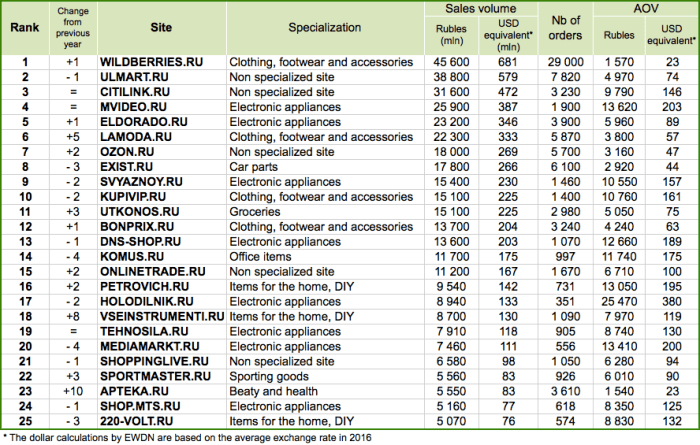Data Insight, a specialized research agency, and Ruward, a publisher of industry rankings, have released their ranking of Russian e-commerce sites in 2016.
Sites are ranked by sales volumes, number of orders and average order value as estimated by the research agency and, in certain cases, confirmed by the companies.
Fashion site Wildberries.ru jumps from second place in last year’s ranking to leadership with sales revenues increasing by an estimated 43%.
Last year’s leader Ulmart.ru — which sells virtually everything from electronic devices, to home appliances, to books and music — is now ranked second, perhaps unfairly. The company’s sales revenues did grow in 2016 (by nearly 6% in rubles), but much less than expected, due to major shareholder disputes, site co-owner Dmitry Kostygin conceded in a media interview.
In addition, Data Insight’s calculations do not take into account the sales generated by Ulmart’s ‘Cybermarkets,’ which are physical outlets where customers make their purchases via computer screens. Maintaining that such sales should be counted as online sales, Ulmart claims to be Russia’s number one e-commerce company with sales nearing $820 million.
KupiVip.ru, Russia’s leading flash sales platform backed by western investors, dropped to 10th place (from 8th place in 2015), following a 9% decrease in sales last year.
Lamoda.ru, a footwear site launched by Rocket Internet in 2011 which is now part of the Global Fashion Group (GFG), reappeared in the Top 10. In 2016, the site’s sales grew by 39%.
Top 25 Russian e-commerce sites in 2016

Sources: Data Insight. See the full ranking (100 sites) in Russian here.
Methodology
Data Insight says that it has used advanced monitoring and measurement methods to complete this research, and that the concerned companies were invited to check and comment on the numbers.
The ranking only includes companies whose e-commerce activities in Russia are run by a legal entity registered in the country. Marketplaces, which the researchers have defined as sites where sales, or the major part of them, are made by third parties, are on their part excluded from the ranking.
This is why key players such as eBay, Yandex.Market and Wikimart, as well as China’s AliExpress and JD.COM, are not integrated in the ranking.
Most importantly, the ranking concerns e-commerce sites, not companies. Thus, the online sales activities of Otto Group, for example, are not ranked as such, but are classified via the group’s distinct brand sites BonPrix.ru, Otto.ru and Quelle.ru.
Market trends
Russia’s e-commerce market continued to grow at double-digit rates last year even as offline retail was severely affected by the economic crisis (see Russian E-Commerce Report).
Online sales in 2016 exceeded $26 billion, growing more than 20% year-on-year. This figure includes some $16 billion for physical goods and $10 billion for online travel.
The cross-border segment is the fastest growing, up 26% by value and 80% by number of parcels and small packages, and exceeded $4 billion for physical goods alone, according to Russian Post and industry association NAMO.
The growth of this segment has been driven in large part by Chinese companies – most notably Alibaba’s B2C marketplace Aliexpress.ru – but key western players including Amazon, Asos, Next and Yoox are also in the game.
This article first appeared in East-West Digital News, the international online resource on Russian digital industries, and is reprinted with permission.
Favorite